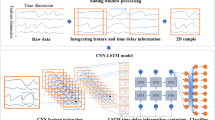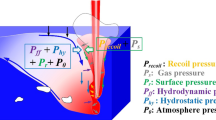Abstract
In power generation industries, boilers are required to be operated under a range of different conditions to accommodate demands for fuel randomness and energy fluctuation. Reliable prediction of the combustion operation condition is crucial for an in-depth understanding of boiler performance and maintaining high combustion efficiency. However, it is difficult to establish an accurate prediction model based on traditional data-driven methods, which requires prior expert knowledge and a large number of labeled data. To overcome these limitations, a novel prediction method for the combustion operation condition based on flame imaging and a hybrid deep neural network is proposed. The proposed hybrid model is a combination of convolutional sparse autoencoder (CSAE) and least support vector machine (LSSVM), i.e., CSAE-LSSVM, where the convolutional sparse autoencoder with deep architectures is utilized to extract the essential features of flame image, and then essential features are input into the least support vector machine for operation condition prediction. A comprehensive investigation of optimal hyper-parameter and dropout technique is carried out to improve the performance of the CSAE-LSSVM. The effectiveness of the proposed model is evaluated by 300 MW tangential coal-fired boiler flame images. The prediction accuracy of the proposed hybrid model reaches 98.06%, and its prediction time is 3.06 ms/image. It is observed that the proposed model could present a superior performance in comparison to other existing neural network models.
Access this article
We’re sorry, something doesn't seem to be working properly.
Please try refreshing the page. If that doesn't work, please contact support so we can address the problem.
Similar content being viewed by others
References
Morrone P, Algieri A, Castiglione T. Hybridisation of biomass and concentrated solar power systems in transcritical organic Rankine cycles: A micro combined heat and power application. Energy Convers Manage, 2019, 180: 757–768
Li X, Huang Y, Zhao D, et al. Stability study of a nonlinear thermoacoustic combustor: Effects of time delay, acoustic loss and combustion-flow interaction index. Appl Energy, 2017, 199: 217–224
González-Cencerrado A, Gil A, Peña B. Characterization of PF flames under different swirl conditions based on visualization systems. Fuel, 2013, 113: 798–809
Golgiyaz S, Talu M F, Onat C. Artificial neural network regression model to predict flue gas temperature and emissions with the spectral norm of flame image. Fuel, 2019, 255: 115827
Bai X, Lu G, Hossain M M, et al. Multi-mode combustion process monitoring on a pulverised fuel combustion test facility based on flame imaging and random weight network techniques. Fuel, 2017, 202: 656–664
Sun D, Lu G, Zhou H, et al. Quantitative assessment of flame stability through image processing and spectral analysis. IEEE Trans Instrum Meas, 2015, 64: 3323–3333
Lin B, Jørgensen S B. Soft sensor design by multivariate fusion of image features and process measurements. J Process Control, 2011, 21: 547–553
Chen H, Yan T, Zhang X. Burning condition recognition of rotary kiln based on spatiotemporal features of flame video. Energy, 2020, 211: 118656
Liu Y, Fan Y, Chen J. Flame images for oxygen content prediction of combustion systems using DBN. Energy Fuels, 2017, 31: 8776–8783
Abdurakipov S S, Gobyzov O A, Tokarev M P, et al. Combustion regime monitoring by flame imaging and machine learning. Optoelectron Instrument Proc, 2018, 54: 513–519
Wang Z, Song C, Chen T. Deep learning based monitoring of furnace combustion state and measurement of heat release rate. Energy, 2017, 131: 106–112
Lu C, Wang Z, Zhou B. Intelligent fault diagnosis of rolling bearing using hierarchical convolutional network based health state classification. Adv Eng Inf, 2017, 32: 139–151
Akintayo A, Lore K, Sarkar S, et al. Early detection of combustion instabilities using deep convolutional selective autoencoders on hi-speed flame video. arXiv: 1603.07839
Qiu T, Liu M, Zhou G, et al. An unsupervised classification method for flame image of pulverized coal combustion based on convolutional auto-encoder and hidden Markov model. Energies, 2019, 12: 2585
Zhu X, Cai Z, Wu J, et al. Convolutional neural network based combustion mode classification for condition monitoring in the supersonic combustor. Acta Astronaut, 2019, 159: 349–357
Truong T X, Kim J M. Fire flame detection in video sequences using multi-stage pattern recognition techniques. Eng Appl Artificial Intell, 2012, 25: 1365–1372
Kim D, Lee H, Cho S. Response modeling with support vector regression. Expert Syst Appl, 2008, 34: 1102–1108
Han H, Cui X, Fan Y, et al. Least squares support vector machine (LS-SVM)-based chiller fault diagnosis using fault indicative features. Appl Thermal Eng, 2019, 154: 540–547
Jiao J, Zhao M, Lin J, et al. A multivariate encoder information based convolutional neural network for intelligent fault diagnosis of planetary gearboxes. Knowledge-Based Syst, 2018, 160: 237–250
Han Z, Li J, Zhang B, et al. Prediction of combustion state through a semi-supervised learning model and flame imaging. Fuel, 2021, 289: 119745
Fei Z, Wu Z, Xiao Y, et al. A new short-arc fitting method with high precision using Adam optimization algorithm. Optik, 2020, 212: 164788
Sun W, Shao S, Zhao R, et al. A sparse auto-encoder-based deep neural network approach for induction motor faults classification. Measurement, 2016, 89: 171–178
Houthuys L, Langone R, Suykens J A K. Multi-view least squares support vector machines classification. Neurocomputing, 2018, 282: 78–88
Tan Z, De G, Li M, et al. Combined electricity-heat-cooling-gas load forecasting model for integrated energy system based on multi-task learning and least square support vector machine. J Cleaner Production, 2020, 248: 119252
Liu C, Tang L, Liu J. Least squares support vector machine with self-organizing multiple kernel learning and sparsity. Neurocomputing, 2018, 331: 493–504
Hsu C W, Lin C J. A comparison of methods for multiclass support vector machines. IEEE Trans Neural Netw, 2002, 13: 415–425
Gubba S R, Ingham D B, Larsen K J, et al. Numerical modelling of the co-firing of pulverised coal and straw in a 300 MWe tangentially fired boiler. Fuel Process Tech, 2012, 104: 181–188
Wang X, Tan H, Niu Y, et al. Experimental investigation on biomass co-firing in a 300 MW pulverized coal-fired utility furnace in China. Proc Combust Inst, 2011, 33: 2725–2733
Han Z, Hossain M M, Wang Y, et al. Combustion stability monitoring through flame imaging and stacked sparse autoencoder based deep neural network. Appl Energy, 2019, 259: 114159
Wan K, Hartl S, Vervisch L, et al. Combustion regime identification from machine learning trained by Raman/Rayleigh line measurements. Combust Flame, 2020, 219: 268–274
Laurens V, Hinton G. Visualizing Data using t-SNE. J Mach Learn Res, 2008, 9: 2579–2605
Author information
Authors and Affiliations
Corresponding author
Additional information
This work was supported by the National Natural Science Foundation of China (Grant No. 51976038), the Natural Science Foundation of Jiangsu Province, China for Young Scholars (Grant No. BK20190366), and the China Scholarship Council (Grant No. 202006090164.
Rights and permissions
About this article
Cite this article
Han, Z., Huang, Y., Li, J. et al. A hybrid deep neural network based prediction of 300 MW coal-fired boiler combustion operation condition. Sci. China Technol. Sci. 64, 2300–2311 (2021). https://doi.org/10.1007/s11431-020-1796-2
Received:
Accepted:
Published:
Issue Date:
DOI: https://doi.org/10.1007/s11431-020-1796-2




